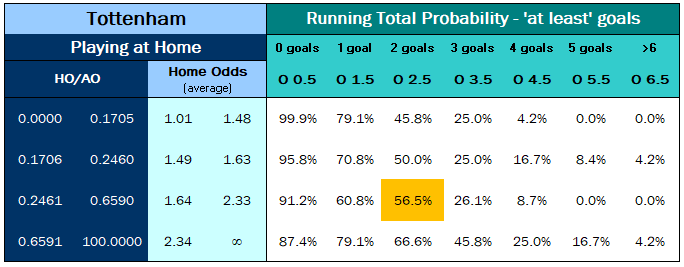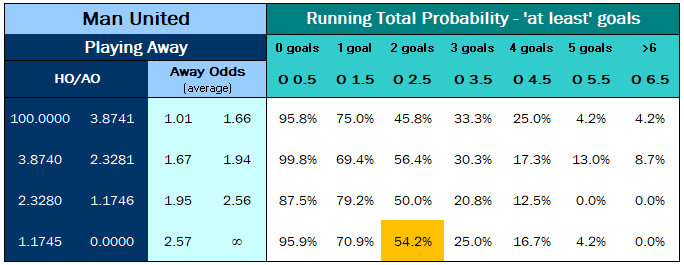
In the world of sports betting, most punters focus on 1×2 match results. Punters are driven to find a system for Home-Draw-Away bets, but regrettably, this bet type is actually one of the most difficult to master and to reap reliable profits from. It takes some time until bettors start to consider other markets such as Betting on Over Under Goals.
To teach you how to make reliable profits with Betting on Over Under we have written a Fundamentals of Sportsbetting course which is accompanied by Cluster Tables.
This article explains some of the mechanics behind the Cluster Tables.

To demonstrate how the cluster tables work and that their use enables you to easily pick a successful portfolio of Over/Under bets for any weekend, we are going to analyse a random EPL weekend with the matches played between 12/5/2017 and 16/5/2017.
For detailed calculations and explanations we are going to be looking at the Tottenham vs. Man United match, played on 14/05/2017.
5 Simple Steps Guide on How to Win Over and Under Betting
- Calculate the HO/AO Quotient
- Pick the Correct Row in the Cluster Tables for the Match
- Calculate the Probability for all Over/ Under Goals Bets and Covert Them into ‘Fair’ Odds
- Compare your Calculated Fair Odds with the Market Odds & Identify the Value Bets
- Decide whether To Lay or To Back
The Cluster Tables have been developed to allow you to quickly calculate the true probabilities/odds for a match that you wish to bet on and then compare the true odds with the actual market prices. To find ‘value’ in the market you need to find the pricing ‘errors’; the bets which are overpriced and the bets which are underpriced.
The truth of the matter is that these are not really ‘errors’, but rather a result of the bookmakers making use of public opinion to maximise their profits. They reduce the prices of bets if the demand is high, and vice versa.
You too can account for ‘public opinion’ as a correction factor when calculating the true odds. This is done via the HO/AO quotient which is explained further down in this article.
Another important detail that you may notice when reading this article and using the Cluster Tables is that we don’t use any goal counts (or ‘form’ considerations, or news) from the current season.
We are going to analyse a round of matches from May 2017, but will be applying the Cluster Table encompassing the five seasons from 2011-12 to 2015-16.
The example is purposely set late in the season to demonstrate that for true betting success you don’t need to worry about ‘current form’, ‘suspensions’, ‘weather’, etc.
Have fun, enjoy & win!
(1) Calculate the HO/AO Quotient
This step is very simple.
Find the match – Tottenham vs. Man United (14/05/2017) – Use www.Oddsportal.com to look up the home and away odds for this game. Most of our tables are based on Pinnacle bookmaker odds, and for these leagues, you need only find which odds Pinnacle is offering at that time.
A small number of our tables use the highest audited bookmaker odds from a select panel included at Oddsportal. For these leagues, you will need to find the highest home and away odds being offered from a small range of bookmakers at the time.
In our example, on the evening before the match, the home win (Tottenham) was priced at 1.85, and the away win (Manchester Utd) at 5.50.
For the HO/AO quotient you then simply divide the home odds (HO) by the away odds (AO).
For those who like odds closer to the game, the highest bookmaker odds just before kick-off were: Tottenham: 1.7 and Manchester Utd: 6.3.
We need this quotient for the next step, but first we will take a look at what this quotient actually means.
In the next step you will also see that both HO/AO quotients – 0.336 and 0.269 – fall in the same cluster group. This will actually (almost) always be the case as the clusters span quite a wide range of corresponding odds. Therefore, it really does not matter WHEN you carry out the calculations!
Bookmakers seldom price their odds to represent the true probabilities. They set odds that follow the public opinion.
We are making use of this public perception as a ‘correction factor’ when trying to find value bets.
This is where the HO/AO quotient comes in handy as a very simple solution. It is possible to find the 1X2 odds for any match played in the past and to calculate their HO/AO quotients.
With the help of the HO/AO quotients it is then possible to cluster matches into groups which represent the ‘perceived’ strength of teams at the time of the match.
For example, a match perceived by the public as being between two equally strong teams at the time of the match will have a quotient between 0.9 and 1.1 (home/away odds, both, in the region 2.5 to 3.0), while strong home favourites may have quotients of 0.04 or 0.05 and so on.
Just tinker around with that, until you get the idea.
Here’s a video to show you the EPL Cluster Table in action.
Notes: Adjust the picture quality at the bottom of the screen above by clicking on the ⚙ button (to the left of the YouTube logo), then click on ‘Quality’ and choose a higher resolution as desired. Go to full screen mode by clicking on the box symbol (to the right of the YouTube logo).
Now we are going to looks at some of the calculation from the video in more detail…
(2) Pick the Correct Row in the Cluster Tables for the Match
After having calculated the HO/AO quotient we are only one step away from picking the Value Bet(s) for this match.
For the sake of the shortness of this article and to keep it sweet and simple, we are only looking at the Over/Under 2.5 Goals bets.
In the match between Tottenham vs. Man United match, played on 14/05/2017, the Over/Under odds for this match were very close: The bet on Over 2.5 goals was priced at 2.00, and the Under 2.5 bet was priced at 1.98.
Which one of the two was the value bet? What should we have picked without listening to our gut feelings?
Remember, the HO/AO quotient was:
The evening before the match: 1.85 divided by 5.5 = 0.336
The closing odds before kick-off: 1.7 divided by 6.3 = 0.269
Here are the screenshots for the distributions for both team (I marked in orange the cell you have to look up the probabilities to calculate the game in the next step).


In the above screenshots, the goal distribution of Tottenham playing at home and Manchester United playing away can be seen.
Please note that for Tottenham we had to pick the second to last row to be in the correct cluster group whilst for Manchester United it was the last row. This is something, that when you start using the Cluster Tables, you will have to be very careful about – to always pick the correct row which corresponds to the calculated HO/AO quotient.
(3) Calculate the Probability of Over/ Under Goals and Convert Them into ‘Fair’ Odds
With the above two tables we can now calculate the probabilities for this particular match.
The calculation is as follows:
110.9% divided by 2 = 55.45% (rounded: 55.4%)
Expected ‘Fair’ Odds: 1 divided by 55.4% = 1.81
Just as a side note, we are calculating with European odds through this website. If you don’t know how to convert probabilities into odds and vice versa, here’s the formula:
If you need to calculate with odds other than European, here’s the article on the topic:
Understanding Betting Odds – Moneyline, Fractional Odds, Decimal Odds, Hong Kong Odds, IN Odds, MA Odds
Next Steps:
(4) Compare your Calculated Fair Odds with the Market Odds & Identify the Value Bets
(5) Decide Whether To Lay or To Back
Wish to play around with the Cluster Table?
Try the EPL Cluster Table for Only £2








Hi. I’ve read the article and i tried to check this strategy if it’s worths trying but no success. In what moment shall i select the highest odds and why these? Can you help me with some info? How are the clusters calculated? How the average odds (home and away) we’re included in quotients between 100.0000 and 38.741. I wait for your answer. Thank you.
Hi Adrian, sorry for the very late reply but better late than never… Here are a few articles on Soccerwidow that may answer your question:
Finding a System Using the HO/AO Quotient
How to Use Soccerwidow’s Over/Under Betting Cluster Tables
Over/Under Goals Market – Betting with Cluster Tables
As a novice this statement seem ludicrous:
“Bookmakers seldom price their odds to represent the true probabilities. They set odds that follow the public opinion.”
I always thought the exchange odds at least are the real odds.
Hi Andrew,
Odds move throughout the ante-post period right up until kick-off based on the weight of money placed by punters. Exchange odds follow the bookmaker lead – they have to, otherwise, there would be arbitrage opportunities everywhere. Accounting for the commission element of exchange odds, they are usually around the same as the leading bookmakers at whatever time you check them.
Rarely do odds represent the true statistical likelihood (based on past statistics) of any particular outcome. A bookmaker may open his book (sometimes months ahead of the event) at the absolute true odds figure, but they cannot possibly stay at the same level – they must either increase if public demand is stronger for the reverse outcomes or decrease if punters are heavily backing, for example, a hot favourite.
I hope this helps in some small way.
hello
how to calculate stake for back bet for the winning capped to 100 at odds lower than 2.00 .
Hi Zinphyo,
Divide your stake by the odds-minus-one.
For example, odds are 1.98. Your desired win is 100.
100 divided by 0.98 = 102.04, which is the stake needed to win 100 units at odds of 1.98.
I hope this helps!
I am sorry for posting these questions under this topic since its about the cluster tables. But here you teach about laying. Ok, I’m using the value calculator. My first question is that how do I identify the lay candidates. Since under over bets are value bets if the yield is bigger than relative standard deviation. But are the bets with smaller yield than relative standard deviation good for laying? Also I’d like to know if it’s good idea to play all the bets that are for value for one match. I mean if I have 3 value bets for let’s say under 2.5 3.5 and 4.5. Is it good practice to play those all or just pick the best bet for my taste? Currently I pick one bet for a match. But is it better this way or the other I mentioned?.
Hi Jari,
Generally speaking, yes, bets with a yield smaller than RSD are worthwhile looking at from a lay perspective.
But to guide you further and also answer your question about whether to play a range of over/under bets in the same match, I’m afraid you will have to paper test to see what works and what doesn’t.
Each league is different, so what works in one league may not necessarily work in the next.
From a personal perspective, I would only take one bet of the same bet type per match as I am risk averse and would not gamble on losing three times on the same result. But everyone is different and has their own personal taste. It’s your decision, sorry!
Thanks for the comment.
Hi Soccerwiddow,
I really appreciate your work and I do always have a good read here. But, considering the method above and trying this by myself it somehow becomes really dependent on the choosen clusters, of course. More precise, I can cluster teams easily to achieve a good ROI in the past but applying those clusters on future games seems not worth doing so. What is your way of clustering? I played around with that a while, but was never able to achieve a positive return over a longer time intervall. Maybe you can give a hint 🙂
Best, Thomas
Hi Thomas,
it’s all about distributions… assuming that you calculated correctly, you will probably achieve a hit rate as expected (in the long run) and you have also probably ensured that you have the mathematical advantage on your side (a positive Yield/Profitability expectation) but unfortunately, the really observed results (almost) never line up like little soldiers in a straight line.
Here are three random scenarios of the same betting strategy: 55% probability (what are usually the Over 2,5 goal bets in the BL1) with an expected Yield of 15% (right click the images to enlarge them in a new window):
.
Above scenario is the gamblers dream… the profit/losses line up in a nice regular manner. Unfortunately, this happens much more rarely that you would think.
.
In above second scenario the gambler needs approx. 120 bets until finally his P/L starts picking up.
.
The image above is a “worst case” scenario – 240 bets, and nothing happens!
.
Please note that image #1 and image #3 (best case and worst case scenarios) achieve at the end similar profits.
There are thousands and thousands scenarios how a random distribution may line up. I’m really sorry but there is absolutely nothing you can do about it except of being very patient. What helps is to increase the probability to win, or even consider arbitrage betting.
Hi there, interesting stuff – just tried it myself on some of the data I had for the premier league; looks promising. One question though, why are the odds ranges different for the away side than at home?
Intrestingly, around the point you made on the timing of analysing the data; when I looked @ Arsenal v Liverpool (both home and away), the ranges seemed pretty consistent for the last few years, so the point at which you review the odds available, seems to make little difference as you suggest.
Hi Matt, to answer your question requires a whole chapter of the course book. I uploaded it for you: Pages 47 to 60 from Fundamentals of Sports Betting Course – Calculating Odds Team vs. Team
For you and everybody else who reads this, please consider purchasing the course book. You’ll find answers not only to the question about “why are the odds ranges different for the away side than at home?” but many many more!
Hi, bought the o/u course and have the bundesliga tables for 2012-17 but the password for the GD by Team sheet on the legal tab doesn’t seem to work.
Could you let me know what the real password is?
Thanks
Hi Jamie, I’ve just sent out an update email. Please check your emails and download the spreadsheet again. The password was wrong. Sorry for your troubles!
Hi,
Is there any way how to calculate over/under odds for 2 goals if I know lines for over/under 1.5 goals and lines for over/under 2.5 goals?
Example:
Total Odds
Over 1.5 1.25
Over 2.5 1.8
Under 1.5 4.6
Under 2.5 2.2
Over 2 ???
Under 2 ???
Hi Miloslav,
If you’d like to learn goal calculation then consider purchasing our course: Fundamentals of Sports Betting
Otherwise you may also find this article helpful: Understanding Goal Lines in Over Under Betting
Out of interest, is the odds clusters approach preferred to using the value bet calculator? Is one approach considered more accurate than the other by yourselves?
Thanks.
Hi Scott,
The OU Odds Clusters are more a tool for systematic betting as they allow you to analyse many games in a very short period of time to produce a diversified portfolio of bets.
The VC calculates ‘Value’ for many bet types, not only Over/Under bets, but requires more time to be filled in. Furthermore, the VC shows ‘value I’ and ‘value II’ – these are indicators for the profitability of a bet and the expected Yield.
Sorry, but I cannot go in any deeper explanation. The topic is too complex and required a whole course. There are both approaches explained in great detail.